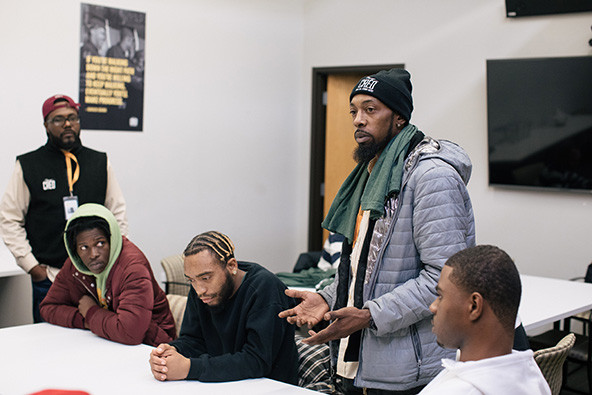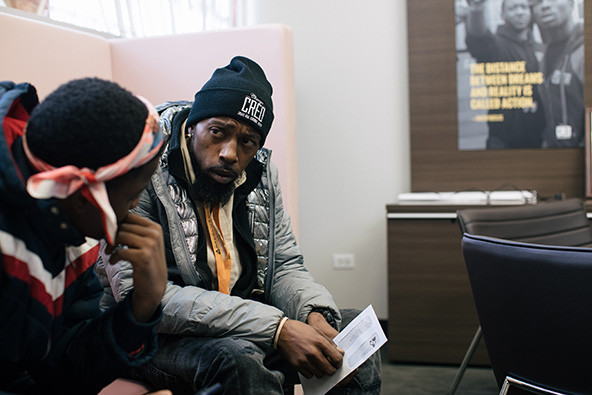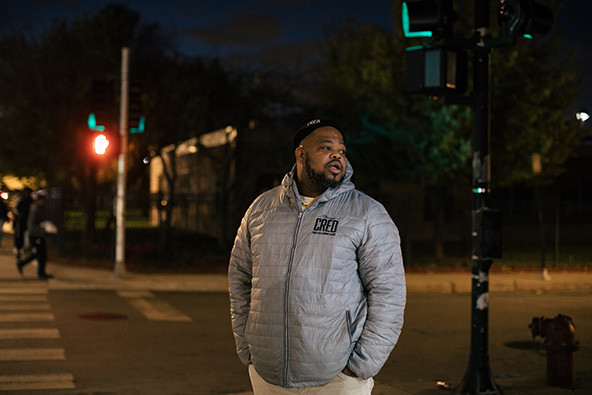 (Photo courtesy of Chicago CRED)
(Photo courtesy of Chicago CRED)
The City of Chicago is the undisputed gun violence capital of America. Last year, the city saw nearly as many shootings and killings as New York and Los Angeles combined, despite having barely a fifth of their combined population. While several other cities have higher per-capita murder rates, the sheer number of shootings in Chicago—more than 4,400 in 2021, including 800 homicides—places my hometown at the epicenter of America’s gun violence epidemic.
Yet, I am hopeful.
For the last six years, through the organization I founded, Chicago CRED, I have been working with men and women at extreme high risk of shooting or being shot. Many have been in and out of the criminal justice system; many have been shot; most have lost loved ones. All of them have witnessed levels of violence that would traumatize the most seasoned soldiers. And like soldiers in battle, they are just trying to survive—to feed and house themselves and their families and to stay safe in their communities.
Are you enjoying this article? Read more like this, plus SSIR's full archive of content, when you subscribe.
Their upbringings were often marred by any number of adverse experiences: substance abuse, domestic abuse, homelessness, mental health struggles, joblessness, educational failure, or hunger. Most were driven to the streets by the same human desires we all have—camaraderie, validation, security, and love. They are the most extraordinary people I have ever known. Their resilience and commitment to transforming their lives and their communities in the face of overwhelming obstacles inspires me every single day.
Chicago CRED
Founded in 2016, Chicago CRED (short for Create Real Economic Destiny) proceeds from the belief that the surest way to stop gun violence is engaging directly with those most at risk of shooting or being shot and giving them a reason to put down their guns. Said another way, we believe that the individuals we work with are not the problem—they are the solution. They are the only ones with the experience, relationships, and courage necessary to do the difficult, dangerous work of reaching out to friends, neighbors, and family members and getting them to also stop shooting.
 (Photo courtesy of Chicago CRED)
(Photo courtesy of Chicago CRED)
Our comprehensive approach includes street outreach, counseling, life coaching, education, and employment. Participants in our program have five separate adults connected to their lives, reachable at all hours, and available to help them cope with everyday challenges. If they have to go to court, we go with them. If they are homeless, we find them housing. If they have been targeted for retaliation, we sometimes take them out of town for a while. And if they are simply emotionally collapsing, we give them love and support.
Many of our outreach workers and life coaches are slightly older versions of the people caught up in gun violence, so they have their trust and respect. We also give participants a modest paycheck, starting at about $125 per week and rising to about $225 per week over the course of our 12-24-month program as long as they stay involved, attend regularly, and advance through the program. Our goal is to help them transition into the legal economy. These are men, not boys. They need to eat and pay rent. It will either be in the legal or illegal economy. That is up to us. By helping them get a job, we change their patterns. They no longer hang out with the same people in the same places. They come to realize that you are safer without a gun than with one.
All told, along with two partner organizations that we directly fund, CRED has served about 1,000 people since 2016. Today, hundreds of them are working in more than 40 different companies in 17 different job sectors including manufacturing, transportation, hospitality, violence prevention, and even professional services. CRED also runs programs serving women and teens and has even set up a manufacturing facility to provide job experiences for participants.
Place-Based and People-Based Strategies
CRED has also developed highly-targeted “place-based” strategies to intervene directly in ongoing disputes drawing on both crime data and street intelligence from our outreach workers. According to the University of Chicago Crime Lab, more than 50 percent of the shootings on Chicago’s South Side take place in less than 8 percent of the blocks, and more than 35 percent of the shootings on the West Side take place in about 5 percent of the blocks. For the most part, these blocks remain consistent from year to year.
 (Photo courtesy of Chicago CRED)
(Photo courtesy of Chicago CRED)
A five-year-old program called FLIP (Flatlining Violence Inspires Peace) puts unarmed men and women with close relationships to active street factions on these most-violent blocks during summertime evenings and weekends. According to research from Northwestern University, last summer, FLIP workers deescalated 639 individual disputes that could have led to violence and helped negotiate 47 non-aggression agreements among opposing street factions. The research further shows that when FLIP workers are present at hot spots, shootings drop to near zero. This summer, over 400 FLIP workers are occupying 90 “hot spot” locations in 14 communities.
This past Memorial Day weekend, the City of Chicago experienced an intolerable level of violence with over 50 shootings, including nine fatalities. Despite the extreme violence citywide, North Lawndale and Roseland, two neighborhoods where CRED has invested most heavily, had none. While we are always humble about our impact, we celebrate every victory. It is hard to measure shootings that don’t happen and even harder to link them directly to our efforts, but the data is certainly reassuring.
CRED’s approach is not foolproof. Because we work with the highest-risk individuals who still live in these neighborhoods, we lose some even as they are going through our program. Since 2016, about two dozen of our participants and alumni have been shot and killed. But Northwestern’s research also shows that participants are about 50 percent less likely to be shot or rearrested than they would be if they were not involved with us. If Chicago took our approach to scale and we reduced victimization rates by 50 percent each year, or even 25 percent, the city could be on par with New York and Los Angeles in just a few years.
Return on Investment: 19-1
CRED’s comprehensive approach costs about $30,000 per year per participant, each of whom typically spends about 18 months in the program. The cost is less than a year in an Illinois state prison ($37,000), and much less than a year in the Cook County Jail ($52,000), where many of our men and women have served time. Bain Consulting conducted a pro-bono analysis for CRED and estimated the financial return on investment for taking violence prevention to scale at 19-1. They also estimated that each shooting prevented can save as much as $1 million dollars in health care, policing, prosecution, and incarceration. No other investment even approaches this level of return. Harder to measure but far more important is the social benefit—saving lives, reducing trauma, transforming communities, and restoring hope.
Private Funding Proves the Model; Public Funding Takes to Scale
Chicago is a city of 2.7 million people. We estimate that the number of people at high risk of shooting or being shot at any one time is about 26,000—or just under 1 percent of the population. Each year, some of these men and women simply age out of the street life, some are killed, some leave town, and some go to prison. But there is an endless pipeline of early teens and pre-teens ready to fill their shoes. Many of our participants started carrying a gun by the age of 15 because they feared for their lives.
By contrast, the number of active street outreach workers in community-based non-profits like CRED is about 250. CRED itself has just 20. That means that for every 100 people at risk, there is just one outreach worker. Boosting that ratio to something closer to 20-1 or even 10-1 should be a top priority for Chicago.
Chicago CRED’s $25 million annual budget is entirely privately funded with the lion’s share coming from Emerson Collective. More than half of our budget funds CRED operations directly, while the rest is spread among two dozen other violence prevention organizations in Chicago. While CRED takes no public funding, our community partners get local and state funding as well as private dollars from a consortium of more than 50 foundations and donors known as the Partnership for Safe and Peaceful Communities. All told, in 2022 Chicago will invest roughly $188 million in public and private dollars on community-based violence intervention programs. Six years ago, that number was much closer to zero.
Going forward, to take this work to scale and dramatically shrink the level of gun violence, Chicago needs something in the neighborhood of $500 million per year in public and private dollars for at least five years. Beyond that, the continuing annual cost may be only half that amount, but the work of engaging directly with young people at risk of gun violence must be a permanent feature of Chicago’s public safety strategy.
The True Cost of Gun Violence
Impressive as the total current investment sounds, it is still just a drop in the bucket compared to what Chicago both spends on the criminal justice system and loses because of crime. The Chicago Police Department alone costs about $1.8 billion annually. When you add in the costs of prosecution, prison, and parole, the direct expenses rise to well over $3 billion per year. Add in health care costs, neighborhood decline, and lost economic activity and the true annual cost of gun violence to Chicago is as high as $7 billion. One poignant illustration of Chicago’s misplaced priorities is that in 2021, Chicago taxpayers spent more than twice as much on police misconduct settlements ($80 million) as on violence prevention ($36 million).
Our city also suffers reputationally and financially from gun violence. Crime is a big reason that Chicago’s Black population has dropped by 400,000 since 1980—more than the entire City of Cleveland, Ohio. In a reverse migration, many have moved back to the South because they fear for the lives of their Black sons. Some areas of the city are all but abandoned, reducing property values for remaining homeowners and tax revenues for the city. Many business owners have gone under. We can only guess how many companies chose not to locate in Chicago or left here because of crime.
First responders are also hurting. Chicago police officers are facing much more gunfire than ever. They are quitting the department in record numbers and the city has struggled to replace them. More than 1,000 positions are currently vacant. Suicide among active-duty Chicago police officers is also up.
Still, we keep throwing money at a sprawling, ineffective criminal justice system that is unable to stop the violence. Even at its currently reduced strength, Chicago has more police per capita than any other big city. And yet, just one in 20 non-fatal shootings leads to an arrest. For fatal shootings, arrest rates citywide are somewhat higher, but in the two neighborhoods where CRED has invested the most—North Lawndale on the West Side and Roseland on the South Side—arrest rates for homicides are only about 10 percent. Absent real justice, we get street justice, and the cycle of retaliation continues—unless someone, like a CRED outreach worker, intervenes.
The Limitless Potential of Our Participants
All that said, we know that programs like Chicago CRED are just one part of the answer. We still need effective policing so that shooters are arrested and face consequences. We need better gun safety laws to stop the flow of guns into Chicago from states with more lenient laws like Indiana and Wisconsin, which account for an estimated 60 percent of the guns recovered in Chicago crimes. And we need a better social radar system to identify people at risk before they pick up a gun, so we can help them make better choices.
Above all, however, we know what our participants are capable of if given a real chance—not a second chance, but a first chance. Consider Jevon Standback.
Growing up in Roseland with a single mother and grandmother who both worked, Jevon’s life took a lonely turn in his early teens when his brother closest in age moved out of town to be with his father. Jevon turned to the streets for friendship and protection. He also bought his first gun—a Hi-Point 9 for $100 dollars. The next decade-and-a-half saw Jevon face numerous gun charges, multiple stints in jail, and eventually a shootout that landed him in the hospital with a bullet permanently lodged in his back. On house arrest in 2019 for yet another gun charge, and now a young father, Jevon enrolled in CRED.
“I realized that all of the things I had done for ‘street credit’ added up to nothing,” he said. “It was all a lie.”
Today, at 34, Jevon is a life coach with Chicago CRED, working with men like himself to escape the streets, learn a skill, and get a job. He is literally saving lives every day. There are thousands of men and women in Chicago just like Jevon. They are born leaders with the same goals and dreams we all have to earn a legal living, support their families, rebuild their communities, and live safely and productively. Providing that opportunity is not up to them. It’s up to us. We don’t have another minute—or another life—to waste.
Support SSIR’s coverage of cross-sector solutions to global challenges.
Help us further the reach of innovative ideas. Donate today.
Read more stories by Arne Duncan.

